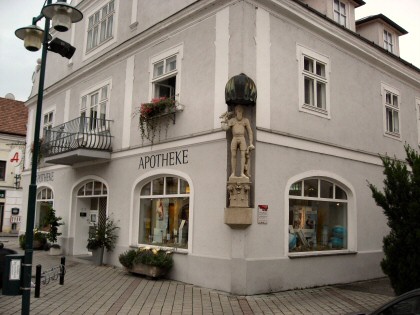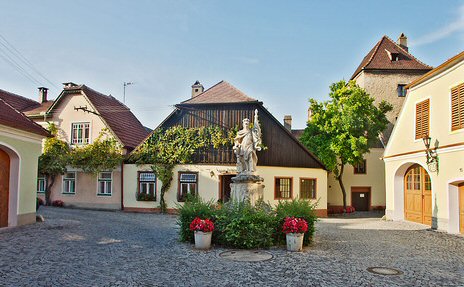On the Schubert Cycle Path
About 14 km after Krems, on the right bank, at the inn on the Danube, the Schubert cycle path branches off. It is an alternative route to the Danube cycle path, which does not have much to offer on this section. The Schubert Cycle Path leads through the Tullnerfeld to various places where Franz Schubert stayed and comes together again with the Danube Cycle Path in Tulln. First it leads to Traismauer.

As we enter the town centre, this Nepomuk statue welcomes us in front of Traismauer Castle.

The foundation walls of Traismauer Castle date back to the 1st century AD, when the building served as a refuge for Roman legionaries.

In the inner courtyard of the chateau we find Gothic and Renaissance elements. This was the seat of the administrative officials of the Salzburg
archbishops*). Today it houses the "Museum of Early History" of the Province of Lower Austria and in the vaulted cellar a vinotheque.
*) Through a land donation by King Ludwig the German, the village came to the Salzburg Archbishopric in 860 and remained in his hands until 1803.
Traismauer was founded by the Romans and was called Augustiana. The Roman gate we passed through was the Porta principalis dextra (right main gate) of the Roman fort. The roof structure is Gothic.

Traismauer also appears in the Saga of the Nibelungs. The king's daughter Kriemhild stayed here before she met King Etzel. On the inside of the Roman gate there is a fresco of the Nibelungs.

From the Song of the Nibelungs
The guests then came to the Traisen
They nursed the man of Rüdiger
Till the Huns were seen riding across the land
Only then did the king's daughter become aware of her great honour.
At the Traisen, the King of the Hun land
A rich castle, well known in the country,
called Traismauer, where Helke once lived
...and cultivated such high clemency as would probably not happen again.
She (Kriemhilde) stayed at the Traisen until the fourth day.
The dust in the streets was not quiet.

At the main square I noticed this statue.
The statue of Roland, which once stood on the pillory column in the middle of the market place, is a symbol of market law and jurisdiction. It was probably erected in 1584.
The baroque gable building dates from the first half of the 17th century and was owned by the Mayreder family from Lebelt for over 120 years. From 1914 the house was used as a coffee house, later it was a department store and now it houses a pharmacy.

The Hungerturm (Starvation Tower, Florianigasse 17) is a Roman horseshoe tower from the 4th to 5th century, which was later incorporated into the medieval town fortifications.
The Florianiplatz (Floriani statue from 1779) is the core area of the early medieval Bavarian settlement.

Floriani Fountain

We leave the city on the Schubertradweg on the Mitterndorferstrasse in the direction of Stollhofen. There we turn right into the Kellergasse. At the crossing with the Wienerstrasse is this Nepomuk statue.
The cycle path continues to the Ahrenberger Kellergasse.
Danube cycle route

